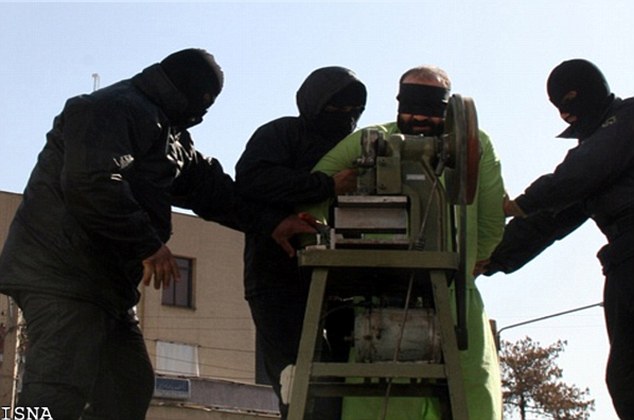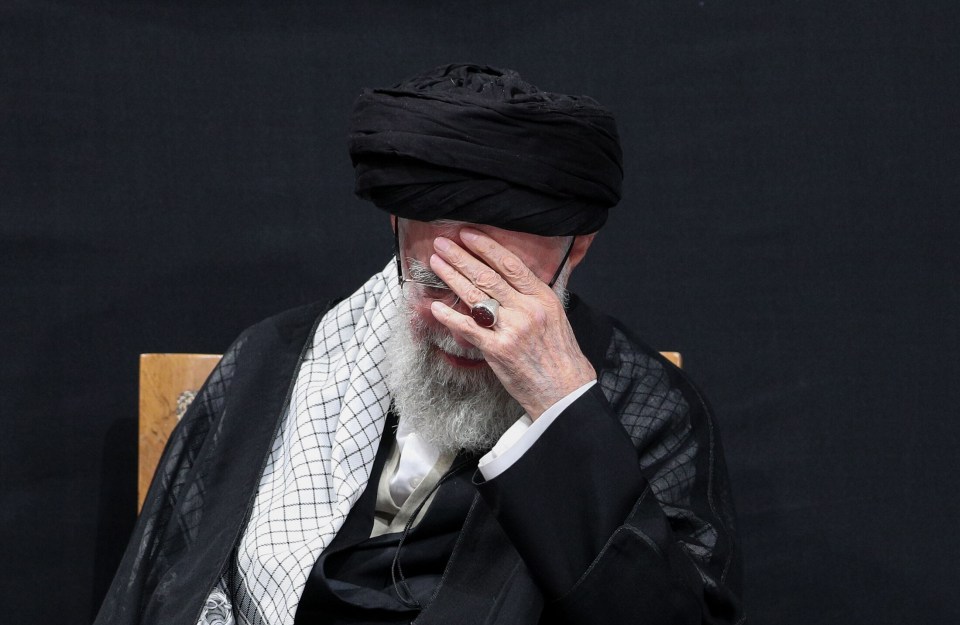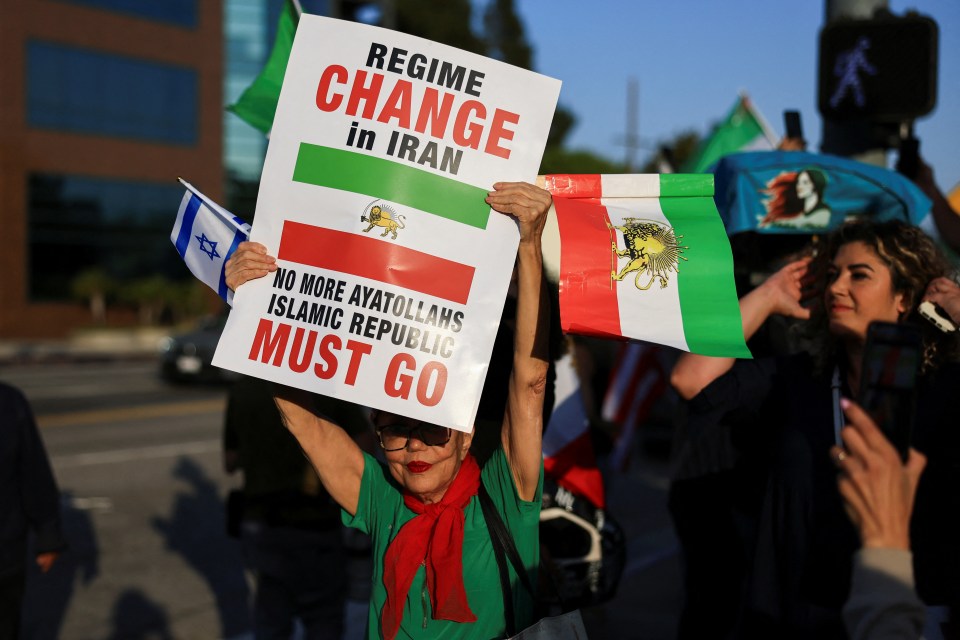Neighbour spying on neighbour, execution sprees & ‘telecom cages’: How Iran is cracking down on critics after 12-day war
TYRANNICAL leaders in Iran have demanded citizens act as undercover informants to turn in anyone who dares oppose the regime, insiders say.
Panicked mullahs have also ordered “telecom cages” be installed around prisons as the regime wages war against its own people.
Political prisoners – largely banished to death row on trumped-up charges – have been subject to extreme torture and a disturbing rate of executions in the face of growing tensions in the Middle East.
Insiders say their treatment is being weaponised to deter opposition.
The fight against repression has loomed large for decades in the rogue state – but the so-called 12-day war last month has made the barbaric Ayatollah more fearful than ever of being toppled.
Ambassador Mark D. Wallace, CEO and Founder of United Against Nuclear Iran, said the Ayatollah is “on his heels” and is “engaging in a purification campaign”.
He told The Sun: “The Ayatollah is incredibly weak and I think what he’s doing is out of fear that his regime is going to collapse.
“He’s looking around, most of his generals have been killed. Those that are alive, he is probably suspicious that they are spies.
“There’s no clear succession, and I think the Ayatollah is on his heels.
“He’s doing everything he can to try to find some sort of path to a succession, and the continuation of this revolutionary regime.”
With Ali Khamenei’s grip weakened by the unprecedented Israeli and US blitz, the incapacitated supreme leader has discharged fresh hell on his own people in a corrupt bid to stifle uprising.
Sources inside Iran told The Sun how a direct alert has been issued to the public, urging them to report any activity linked to resistance groups of the People’s Mojahedin Organisation of Iran (PMOI/MEK).
Regime loyalists have been implored to act as informants – compiling detailed reports with photos, times, locations, licence plates and facial features of suspected individuals.
Orders were publicised in an official government news outlet – marking a distinct shift in the paranoid regime’s usual strategy of covert suppression.
Insiders noted it points to the regime’s growing perceived threat posed by the PMOI’s grassroots operations.
The PMOI has long fought for a secular, democratic Iran, and is understood to be gaining traction amid frustration with economic hardship, political repression, and international isolation.
Iranians have lived under the iron-fist rule of fanatics ever since the revolution in 1979 saw the country transformed into an Islamic republic.
The close-knit cadres have attempted to thwart opposition by any means necessary for 46 years – but now lie incredibly vulnerable.
Anxious mullahs forced a complete shutdown of internet access in government offices during the conflict last month to take full control of information flow.
Iran regime massacres inmates

by Katie Davis, Chief Foreign Reporter (Digital)
IRAN’S ruthless regime massacred defenceless inmates at a prison before blaming their deaths on shrapnel from airstrikes, insiders revealed.
Cold-blooded regime dictators have also ordered the arrest of hundreds after accusing them of having links to arch-foe Israel.
As Israeli missiles rained down on a nearby military site on June 16, panicked inmates at Dizel-Abad Prison in Kermanshah begged to be moved to safety.
But they were instead met with a hail of bullets from the regime’s merciless enforcers in a “deliberate and cold-blooded act”, a witness said.
The source from within the prison said: “The prisoners insisted they be moved from areas where windows had shattered and where they feared further missile strikes.
“The regime’s answer was bullets.
“The special forces opened fire directly at unarmed, defenseless inmates who were merely trying to flee a danger zone.”
Insiders said the prisoners faced live ammunition after guards began beating inmates when they tried to breach internal doors in a bid to get to safety.
At least ten people were killed and a further 30 injured.
Regime authorities are now said to be attempting to cover up the deaths.
One source said: “Officials are planning to falsely attribute the deaths to shrapnel from the airstrike, not their own gunfire.”
Universities were mandated to create “war monitoring rooms” on every campus – which continue to put the personal social media activity of professors and students under surveillance.
Meanwhile, the Supreme National Security Council is installing “telecom cages” at prisons around the state to sever any external communications inmates have.
Jamming devices have been deployed to disrupt messages and calls being made – preventing any contact with the outside world.
It comes as execution numbers have spiralled in recent weeks – with 424 recorded since March 21, according to figures from the National Council of Resistance of Iran (NCRI).
In just three days during the conflict between Israel and Iran, 17 prisoners – including one woman – were executed.
One source said: “This surge is a deliberate tactic to instill fear and crush resistance.”
Wallace, who served as the US ambassador to the United Nations, said the regime has ramped up its “vicious clampdown” to prevent “people pouring out in opposition in the streets”.
The ex-diplomat added: “You see real Iranians suffering every day in those streets, and we cannot forget about them.
“The only path ultimately for the regime to fall is solely in the control of the Iranian people.
“Sadly, the Iranian people will suffer, and many will likely have to die for that to happen, and they’re being persecuted as we speak today.
“I’m sure there are people being imprisoned and likely will meet their death because of the crackdown of that state security apparatus.
“It’s really essential that we do not forget the people of Iran that are the victims of this regime.”
The NCRI has warned how four political prisoners are facing severe torture as regime enforcers try to extract forced confessions to try and link them to the deaths of two notorious regime judges.
Plight of four prisoners
FOUR political prisoners are being subjected to prologner interrogation and torture in efforts to extarct fabricated confessions, insiders say.
NCRI sources say the regime is trying to link Arghavan Fallahi, Bijan Kazemi, and Mohammad and Amirhossein Akbari Monfared, to the deaths of regime executioners Moghiseh and Razini.
Fallahi, 25, was arrested at her home in Tehran on January 25, and was taken to Ward 241 of Evin Prison.
She spent 25 months in solitary confinement and after the prison was evacuated last month she was moved to solitary confinement in Fashafouyeh (Greater Tehran Prison).
Fallahi was previously arrested in November 2022 along with her father, Nasrollah Fallahi, a political prisoner from the 1980s, and was later released.
Nasrollah, who is serving a five-year prison sentence, is now being held in Fashafouyeh Prison.
Kazemi, meanwhile, was arrested by intelligence agents in Kuhdasht on January 20 and was put in solitary confinement in Ward 209 of Evin Prison before being moved to Fashafouyeh.
Interrogators claim Kazemi, 44, provided weapons to the assailants of Razini and Moghiseh.
Kazemi was arrested before in March 2020 and imprisoned for over two years in Khorramabad Prison.
He was released but was fitted with an ankle monitor for more than a year for surveillance.
Amirhossein, 22, was detained on January 19 – a day after Razini and Moghiseh were killed.
He was taken to Ward 209 of Evin Prison and has been subjected to severe torture, insiders say.
Two days later, intelligence agents raided his home again and arrested his father Mohammad.
Mohammad was previously a political prisoners in the 1980s, and was also arrested during the 2022 uprising.
Four members of their family were executed in the 1980s – PMOI members Alireza, Gholamreza, Abdolreza, and Roghieh Akbari Monfared.
Their sister, Maryam Akbari Monfared, is serving her sixteenth year in prison for seeking justice for her siblings.
Arghavan Fallahi, Bijan Kazemi, and father and son Mohammad and Amirhossein Akbari Monfared have been subjected to prolonged interrogation and could face the death penalty.
Despite this, defiant campaigners have continued their “No to Execution Tuesdays” movement – uniting activists and the families of inmates.
Zolal Habibi, of the NCRI’s Foreign Affairs Committee, told The Sun: “Even in the midst of war, the clerical regime in Iran has not paused its machinery of executions and repression for a single day.
“This chilling reality underscores a deeper truth: the primary war in Iran is not external, but internal — a war between the Iranian people and their organised resistance on one side, and the ruling religious dictatorship on the other.
“Yet amid this brutality, the resilience of the Iranian people shines through.
“Last Tuesday, political prisoners across 47 prisons -the most tightly controlled spaces in the country – continued their campaign against the death penalty for the 74th consecutive week.
“Their defiance is a source of pride for every Iranian who dreams of freedom.”







